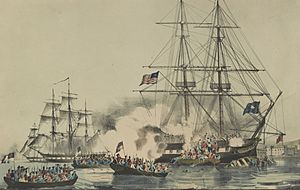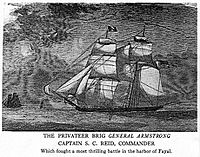Battle of Fayal facts for kids
Quick facts for kids Battle of Fayal |
|||||||
|---|---|---|---|---|---|---|---|
| Part of the War of 1812 | |||||||
 General Armstrong fighting British forces off Fayal |
|||||||
|
|||||||
| Belligerents | |||||||
| Commanders and leaders | |||||||
| Strength | |||||||
| Land: 3 artillery pieces 1 shore battery Sea: 1 brig 90 men |
1 brig-sloop 12 armed boats 400 Royal Navy sailors and Royal Marine infantry |
||||||
| Casualties and losses | |||||||
| 2 killed 7 wounded 1 brig scuttled Total: 9 |
36 killed 93 wounded 2 armed boats sunk 2 armed boats captured 1 brig-sloop damaged Total: 129 |
||||||
The Battle of Fayal was an important sea battle during the War of 1812. It happened in September 1814, near the city of Horta on Faial in the Azores. This island was part of the Portuguese Empire, which was a neutral country during the war.
In this battle, three British warships and many boats full of soldiers attacked an American privateer ship. A privateer was a privately owned ship that was allowed by its government to attack enemy ships during wartime. The American ship, called General Armstrong, was in the port. The Americans fought off two attacks from the British. They even killed one of the British commanders. The Americans won the battle, but they had to sink their own ship the next morning. They did this to stop the British from capturing it.
The British tried to land troops on the island after the battle. But the Portuguese governor and the American consul (a government official) on Faial stopped them. The British Navy then sailed away to continue their mission against New Orleans.
Contents
Why the Battle Happened
The British Navy had three ships sailing towards the Caribbean. These ships were the HMS Plantagenet, a large warship with 74 cannons, the HMS Rota, a frigate with 38 cannons, and the HMS Carnation, a smaller warship called a brig-sloop with 18 cannons. They were getting ready for a big attack on New Orleans.
On the night of September 26, 1814, these three British ships were near Fayal Island. They saw the American ship General Armstrong. This ship was a type of fast sailing ship called a Baltimore clipper. It had seven cannons and a crew of about 90 sailors. Captain Samuel Chester Reid commanded the General Armstrong. He was not going to give up his ship without a fight.
The British Captain Robert Loyd sent a small boat from the Plantagenet to find out what country the General Armstrong belonged to. When the British boat got close, Captain Reid warned them. He said he would fire if they came any closer.
The Battle Begins

British reports say that their boat couldn't stop because of the strong ocean currents. It drifted too close to the General Armstrong. The Americans then fired their cannons. They hit the British boat, killing two men and wounding seven others. The British boat quickly moved away.
The British ship Carnation then moved closer to the American ship. They tried to talk things out, but the talks failed. Since the General Armstrong had fired first in a neutral port, the Carnation decided to attack. They sent four boats full of armed men towards the General Armstrong. Captain Reid moved his ship closer to the shore.
The first attack happened around 8:00 pm. The Americans saw the boats coming and got ready. In the fight, the Carnation was kept away by American cannon fire. The British boats were forced to retreat. Captain Reid estimated that 20 British soldiers were killed and 20 were wounded. Only one American was killed and one was wounded.
Second British Attack
Around 9:00 pm, the British launched a bigger attack. They sent 12 boats, each with cannons. These boats carried 180 marines and sailors from the Plantagenet and Rota. The Carnation pulled these boats into position, but stayed out of range of the American cannons. The boats split into three groups for the attack. Lieutenant William Matterface led the boats. The larger British ships, Rota and Plantagenet, stayed a few miles away and did not join the fight.
Just after 9:00 pm, the British boats moved forward. But the Americans fired accurately, and strong currents made it hard for the British to get close. The Carnation was damaged. It took Lieutenant Matterface and his boats until about midnight to reach the General Armstrong. This was partly because of the current and partly because the main British ships were so far away.
While waiting, the Americans moved three of their cannons onto the shore. They set up a small shore battery (a group of cannons on land). When the British boats finally arrived, they tried to board the General Armstrong. But the American gunners were ready. They sank two British boats before they could get close. They also captured two more boats. Many British soldiers who tried to board were killed at very close range with swords and muskets. Lieutenant Matterface and several other British officers were killed. No one of high enough rank was left to lead the remaining British forces.
Aftermath of the Battle
In total, 36 British sailors and marines were killed in the battle. Another 93 were wounded. The main fighting lasted over half an hour. Only two Americans were killed, and seven were wounded. Captain Reid himself was hit by a musket ball. Reid's crew fired unusual things from their cannons, like nails, knife blades, and brass buttons. These caused serious injuries to the British.
After being defeated, the British slowly rowed back to their ships. It was 2:00 am on September 27 when they finally reached them. Captain Loyd decided to send the Carnation back to destroy the General Armstrong after sunrise. But when the Carnation arrived, American fire caused more damage to it, so the British ship stopped its attack.
A little later, the Carnation appeared again. But Captain Reid had already decided to sink his own ship. He fired one of his cannons straight through the hull of the General Armstrong. As the ship sank, the British boarded it and set its sails on fire.
Captain Reid and his crew escaped to the shore. The British wanted to send soldiers to search for the Americans on land. But the Portuguese governor and the American consul, John Bass Dabney, stopped them.
Captain Reid and his crew were first seen as heroes in America. People thought they had helped delay the British attack on New Orleans. However, later studies by historians showed that this probably wasn't the case.
Some historians also disagree with the common story of the Battle of Fayal. An English eyewitness and official reports from the American embassy and Portuguese records suggest that the British squadron intended to illegally capture the General Armstrong in secret. They argue it wouldn't make sense for the British to send fully armed boats just to find out the ship's nationality. They could have simply contacted their own consulate or the American consulate, or sent a peaceful group to the ship while it was docked.
Images for kids
-
"Night battle of the Privateer Brig General Armstrong of New York" by Emanuel Leutze.




